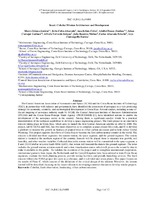Irazú: cubesat mission architecture and development

Date
2016Author
Gómez-Jenkins, Marco
Calvo-Alvarado, Julio
Julieta-Calvo, Ana
Chaves-Jiménez, Adolfo
Carvajal-Godínez, Johan
Valverde-Salazar, Alfredo
Ramirez-Molina, Julio
Alvarado-Briceño, Carlos
Carrasquilla-Batista, Arys
Metadata
Show full item recordAbstract
The Central American Association of Aeronautics and Space (ACAE) and the Costa Rican Institute of Technology (TEC), in partnership with industry and government, have identified the promotion of aerospace as a very promising strategy for economic, scientific, and technological development in Costa Rica. Several studies, including a state-of-the-art mapping of aerospace industry made by ACAE, the Central American Institute of Business Administration (INCAE) and the Costa Rican Foreign Trade Agency (PROCOMER) [1], have identified actions to enable the development of the aerospace sector in the country. Among them, a significant catalyst would be a practical demonstration of the technical capabilities to develop a space engineering project. The Irazú project is an innovative mission taking place in Costa Rica, which aims to launch the first Central American satellite in orbit by 2018. The project, led by ACAE and TEC, has two main objectives: a) to complete a space project life-cycle, and b) to develop a platform to monitor the growth in biomass of planted trees to offset carbon emissions and to help reduce Global Warming. This project supports the efforts of Costa Rica to become the first carbon neutral country in the world. The mission is divided into three segments: the remote station, the space segment, and the ground segment. The remote station is located at the northern region of the country. Sensors will be placed there to measure tree growth, soil humidity, and other weather variables. Collected data in the remote station will be transmitted to the space segment, a 1 unit (1U) CubeSat in Lower Earth Orbit (LEO), that in turn will transmit the data to the ground segment. The latter includes the ground station, mission control, and a data visualization center, which will process the scientific data to make it available to the public. To validate the execution of the project and to strengthen international cooperation, international partners from Japan, the Netherlands and the United Kingdom have been enlisted to train Costa Rican engineers, evaluate the work planning process, provide testing facilities, and provide launching services. The Irazú mission follows the NASA project life-cycle as a reference, and it is divided into seven phases. This paper focuses on the results of Phase C, which consists of the definition of the critical design of the mission. Moreover, the lessons learned will be described, focusing on the issues relevant to developing countries that aim to develop similar projects.
Description
Artículo
Source
Proceedings of the International Astronautical Congress, IACShare
Metrics
Collections
- Artículos [28]

